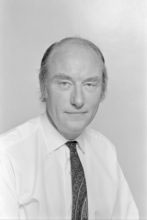Francis Crick (1916 – 2004)
 Francis Crick, who had suffered from cancer for some time, died in La Jolla on 28th July.
Francis Crick, who had suffered from cancer for some time, died in La Jolla on 28th July.
He will be best remembered for DNA, whose structure he discovered with Jim Watson in 1953. The structure suggested not only a possible copying mechanism for the genetic material; it implied that the genetic information was held in the linear sequence of bases in DNA.
If proteins are encoded in DNA, he surmised, then there might be a linear relationship between the bases in DNA and the amino acid sequences of proteins. That proteins are linear sequences had been discovered earlier by Fred Sanger when he determined the sequence of insulin. We now know this relationship between gene sequence and protein sequence as the “Genetic Code”; it was the unravelling of this which was to consume Francis’ energies for the next 15 years. It brought him to focus on how proteins are made on ribosomes, and his formulation of the “Adaptor Hypothesis”, which predicted the existence of small nucleic acid molecules which could act to place amino acids in the correct sequence as the template is read. Transfer RNAs, which have that role, were shortly after discovered. The logical structure lying at the heart of molecular biology came more clearly into focus with the discovery (largely by Sydney Brenner and his colleagues) of messenger RNA in 1961.
Prior to then, a major route for trying to understand the relationship between genes and proteins came from studies of mutations, particularly those in the haemoglobins, where the change of one amino acid for another was presumed to reflect the change of a single base in the gene. Francis’ interest in mutations led to his realisation that acridine mutagens insert (or delete) a DNA base pair. From this came, in 1961, what is probably the finest paper in genetics: the demonstration that genes are translated from one end of the template and by three bases at a time. The solution of the Code lay in the hands of biochemists once it was discovered that polyU coded for polyphenylalanine. Francis’ last major contribution, during his years as a molecular biologist in Cambridge, was the “Wobble Hypothesis”, which explained the structural relationship between codon and anti-codon.
Francis was born in 1916 into a family with little academic background: his father owned a shoe factory. He gained a B.Sc. in physics in 1937 from University College, London and started a Ph.D. with E.N. da C. Andrade, measuring the viscosity of water above 100°C. This was interrupted with the outbreak of war, when he moved to the Admiralty to work on the design of acoustic and magnetic mines. With the ending of the war, he worked briefly at the Strangeways Laboratory in Cambridge on the viscosity of the cytoplasm of fibroblasts and in 1949 joined Max Perutz’s MRC Unit in the Cavendish Laboratory at Cambridge University, to work on the X-ray crystallography of proteins, especially haemoglobin. It was here that he helped solve the structure of DNA and initiated work on the genetic code.
Francis was a person of incredible intellect and imagination. Although a theoretician (he had little patience for experiments, with the notable exception of his initial work on the acridine mutant story), he placed great weight on the results of experiment and was always careful to give credit to the individual who had done it. He had a fine sense of humour and a wonderfully infectious laugh. With Sydney, who joined him in the early 1950s, he shared a close and extraordinary scientific companionship. Between them – with Sydney’s imagination and Francis’ logic – they helped bring an intellectual vitality to the MRC Unit in the Cavendish and, later, to the LMB which placed it at the centre of the new field of molecular biology. Among the group of immensely talented scientists who founded the LMB and created its special character, Francis Crick was the intellectual star.
Francis was interested in biology in a broad sense: why we are here and how we function. He loathed religion and was fascinated by problems, such as how patterns are formed in biology, or those posed by the origins of life, or how the brain works. In 1976, he and his wife, Odile, left Cambridge for the Salk Institute in La Jolla. There, he immersed himself in trying to define how we are aware of things – consciousness. He continued with this until he died, defining the important goal of trying to find a neuronal correlate of consciousness.
[Mark Bretscher, 29.7.04]
- Francis Crick’s Obituary, from the Independent can be downloaded here (pdf).